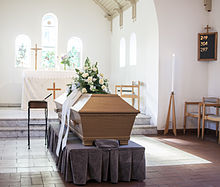Church burial
The church burial is a service on the occasion of the death of a Christian . Occasionally or depending on the region, it is also referred to as a funeral , burial ceremony , burial , funeral service , memorial service , funeral service or - as in Switzerland - as abdication and - in Austria - as blessing .
The church burial traditionally consists of three parts:
- Opening and collection from the mourning house
- Funeral service in the church, chapel, funeral hall or funeral hall
- Burial at the grave
The opening in the mourning house as a direct part of the three-part memorial service is rarely carried out today. On the other hand, a blessing on the death bed or as a farewell when collecting the corpse in the dying house is even more common.
Catholic burial

In the Roman Catholic Church , the liturgical rite of burial is called Church funeral service or, according to the older Latin name, exsequien (from Latin exsequi , "to lead out"). The rite is shaped by the belief in the continuing community of living and deceased Christian believers. It can consist of three (starting point - church where the Requiem is celebrated - grave site) or fewer stations.
The church funeral is one of the sacramentals , the signs that have an effect on salvation. It is generally led by the priest or deacon , but can also be led by worshipers .
Evangelical burial
The Protestant funeral service is usually a public church service. The focus is on the message of the gospel for the living. At the same time, the burial is seen as a pastoral service to the bereaved. In addition, there is the conscious farewell to the deceased; therefore, according to the regulations of some regional churches, the coffin or urn should be present at the celebration. Church ordinances describe this service as a service of love:
“The church burial is held as a divine service. The Christian community thus renders the last love service to its deceased and, in the face of death, proclaims the rule of the risen Lord over the living and the dead. "
As a rule, the congregation meets in a church, chapel or funeral hall that is near the cemetery or in the cemetery . The coffin or urn with the remains of the deceased is usually in the front of the altar area or under a cross, decorated with candles and flowers.
The burial service usually consists of two parts: “In the chapel or church” and “At the grave”. Their order can vary depending on local or regional conditions and tradition:
- Beginning with the funeral service in the chapel or church , followed by the burial at the grave: With this traditionally common form, the funeral immediately follows the funeral service. However, an interval of up to several weeks is also possible within the scope of an urn burial .
- Celebration only at the grave: This happens especially where no chapel or church is available, e.g. B. in natural burials , occasionally also in the burial of the deceased who no longer have any relatives.
- Celebration only in the church or chapel: If the deceased has requested an anonymous burial , the celebration usually only takes place in the church or chapel. In this case, the burial takes place without the accompaniment of a pastor or relatives.
- Celebration that begins at the grave and then continues in the church or chapel: This type of form is common in some places, for example where the coffin cannot be set up in the church or chapel due to the space available.
The funeral service is normally led by a pastor and contains - in the German Protestant liturgy - the following elements
In the chapel or church
- Music at the entrance
- Peace greeting
- Introduction and biblical vote
- Church song
- Psalm or opening prayer
- Silent prayer
- Scripture reading
- sermon
- Creed
- prayer
- Foreword
- Music to the extract
If the burial follows immediately, the coffin or urn is led to the grave after the funeral service to the ringing of bells (if available), while the congregation follows as a funeral procession .
At the grave
The church burial comes to its goal with the burial of the mortal remains: "Earth to earth, ashes to ashes, dust to dust" are the words of burial in many Protestant orders of worship. The coffin or urn is lowered into the grave there after a final prayer; at last the church is dismissed with the blessing.
- Choral or instrumental music
- funeral
- Scripture reading of the resurrection
- Our father
- blessing
- Choral or instrumental music
literature
- Agende for Evangelical Lutheran churches and parishes, Volume III: The official acts, Part 5: The funeral , Hanover 1996
- Funeral agenda of the Evangelical Church of Württemberg, there in particular the service book, chapter funeral: basic forms (PDF; 125 kB)
Individual evidence
- ↑ Austrian dictionary. 38th edition, p. 272.
- ↑ Divine service book, chapter Burial: Introduction , p. 11f. (PDF; 52 kB)
- ↑ Church regulations of the Evangelical Church in Württemberg, 1969
- ^ Agende for Evangelical Lutheran churches and parishes, p. 44
- ↑ Württembergische Agende p. 38f.


